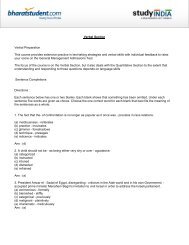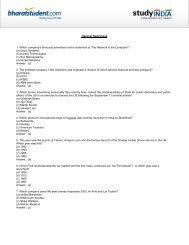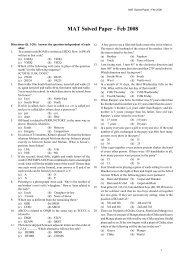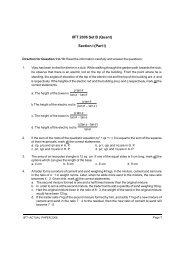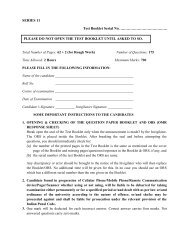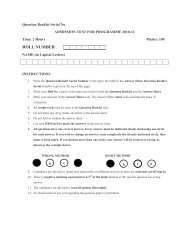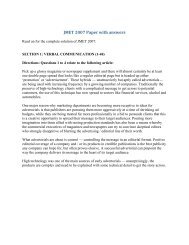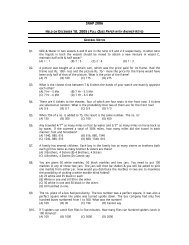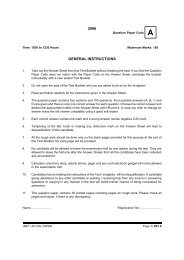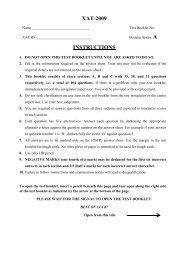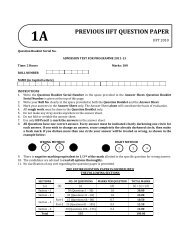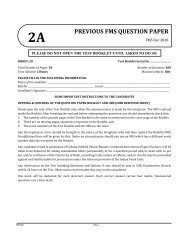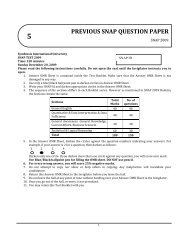JMET 2009 - Testfunda
JMET 2009 - Testfunda
JMET 2009 - Testfunda
You also want an ePaper? Increase the reach of your titles
YUMPU automatically turns print PDFs into web optimized ePapers that Google loves.
<strong>JMET</strong> <strong>2009</strong><br />
B 1/36<br />
Question Paper Code B<br />
Time: 10:00 to 13:00 Hours Maximum Marks: 120<br />
GENERAL INSTRUCTIONS<br />
1. Take out the Answer Sheet from this Test Booklet without breaking the seal. If you find that the<br />
Question Paper Code does not match with the Paper Code on the Answer Sheet, exchange the<br />
booklet immediately with a new sealed Test Booklet.<br />
2. Do not open the seal of the test Booklet until you are asked to do so by the Invigilator.<br />
3. Carefully read and follow all the instructions given in the Answer Sheet.<br />
4. The question paper contains four sections and 120 questions. Four possible answers (A, B, C and D)<br />
are given and there is only one correct answer for each question. Choose the correct answer and<br />
darken the appropriate bubble in the Answer Sheet with HB pencil. In case you wish to change an<br />
answer, erase the old answer completely using a good soft eraser.<br />
5. Each correct answer carries one mark and each wrong answer carries negative 0.25 marks.<br />
6. For a candidate to qualify, he/she should not only secure certain minimum marks in the test paper,<br />
but also necessarily obtain certain minimum marks in each of the four sections.<br />
7. Tampering with the Bar Code or making any distinctive mark on the Answer Sheet will lead to<br />
disqualification of the candidate.<br />
8. All the rough work should be done only on blank pages provided for this purpose at the end of this<br />
Test Booklet. No extra page will be provided.<br />
9. No candidate will be allowed to leave the examination hall for any reason during the test. Candidates<br />
are allowed to leave the hall only after the Answer Sheets from all have been collected and<br />
accounted for.<br />
10. Calculator, electronic diary, cellular phone, pager and any such electronic gadget will not be allowed<br />
in the examination hall.<br />
11. Candidates found violating the instructions of the Test/Invigilator will be disqualified. A candidate<br />
giving assistance to any other candidate or seeking/receiving help from any source in answering<br />
questions or copying in any manner in the test will forfeit his/her chance of being considered for<br />
admission.<br />
12. This Question paper contains 36 printed pages including pages for rough work. Please check all<br />
pages and report, if there is any discrepancy.<br />
Name:…………………………. Registration No.:……………..
SECTION 1: VERBAL COMMUNICATION (Questions 1 - 30)<br />
Direction: Questions 1 – 4 relate to the passage given below:<br />
Can poor countries afford to be green? That is a question which politicians in the developing world have<br />
often asked pointedly. To them, it seems that the obsession of some rich type with preserving forests and<br />
saving cuddly animals like pandas or lemurs, while paying less attention to the human brings living<br />
nearby, is both cynical and hypocritical. There is of course plenty of evidence that greenery and growth<br />
are not polar opposite. After decades of expansion in China and other fast-emerging economies, some of<br />
the negative side-effects and their impact on human welfare, above all the death toll caused by foul air<br />
and water, are horribly clear. Yet the relationship between growth and the state of environment is far<br />
from simple. Some experts feel that poor countries have been quiet right to challenge the sort of green<br />
orthodox which rejects the very idea of economic growth. Indeed, the single biggest variable in<br />
determining the countries ranking is income per head. But that doesn‘t imply that economic growth<br />
automatically leads to an improvement in the environment. Growth does offer solutions to the sorts of<br />
environmental woes (local air pollution, for example) that directly kill humans. This matters, because<br />
about a quarter of all deaths in the world have some link to environmental factors. Most of the victims<br />
are poor people who are already vulnerable because of bad living conditions, lack of access to medicine,<br />
and malnutrition. Among the killers especially of children, in which the environment plays the role, are<br />
diarrhoea, respiratory and infections and malaria. These diseases reinforce a vicious circle of poverty<br />
and hopelessness by depressing production. According to the World Bank, the economic burden on<br />
society caused by bad environmental health amounts to between 2% and 5% of GDP. As poor countries<br />
get richer, they usually invest heavily in environmental improvements, such as cleaning up water<br />
supplies and improving sanitation, that boost human health. But the link between growth and<br />
environmentally benign outcomes is much less clear when it comes to the sort of pollution that fouls up<br />
nature (such as acid rain, which poisons lakes and forests) as opposed to directly killing human beings.<br />
The key to addressing that sort of pollution is not just money but good governance. Hence the poor<br />
Dominican Republic is much healthier than nearby Haiti, Costa Rica is far ahead of Nicaragua, in spite<br />
of broadly similar nature and resources, and wealthy Belgium is the sick man of Western Europe, with<br />
an environmental record worse than that of many developing countries.<br />
Q.1 The passage DOES NOT talk about:<br />
(A) the impact of environmental health on economic growth.<br />
(B) factors determining good governance.<br />
(C) the impact of economic growth on environment health.<br />
(D) environmental factors affecting child mortality.<br />
Q.2 Which one of the following statements CANNOT be inferred from the passage?<br />
(A) Fast-emerging economies are responsible for polluting their environment.<br />
(B) Bad environmental health affects a country‘s production.<br />
(C) Environment can be protected only after economic prosperity has been achieved.<br />
(D) The link between the state of the environment and human health is ambiguous.<br />
B 2/36
Q.3 The MOST APPROPRIATE title for the passage would be:<br />
(A) How Green is Their Growth?<br />
(B) Green Orthodoxy<br />
(C) Growth vs Greenery<br />
(D) Global Warming<br />
Q.4 Which one of the following can be MOST APPROPRIATELY inferred from the passage?<br />
(A) Environmental health should be the single biggest variable in determining a country‘s<br />
ranking.<br />
(B) Poor countries cannot afford to save forests or protect cuddly animals.<br />
(C) Haiti, Nicaragua and Belgium are the most polluted countries in the world.<br />
(D) Economic progress can help to ease environmental woes, as long as the governance is good<br />
Direction for Questions 5 and 6: Choose the word which is OPPOSITE in meaning to the word<br />
given in CAPITAL LETTERS:<br />
Q.5 FATUOUS<br />
(A) stupid (B) obese (C) intelligent (D) sincere<br />
Q.6 TRACTABLE<br />
(A) obedient (B) capable (C) corruptible (D) stubborn<br />
Direction for Questions 7- 9: Choose the grammatically CORRECT option from the sentences<br />
given below:<br />
Q.7 (A) I requested the principle to remove me from the operation since it was going against my<br />
principals.<br />
(B) I need to move further away from home in order to continue farther education.<br />
(C) Knowledge of economical theories need not be helpful in making economic products.<br />
(D) I have been working continuously for the last three months while she is continually taking<br />
days off.<br />
Q.8 (A) Each of the finalists were exceptionally good and the choice for the best one among all three<br />
was very difficult indeed.<br />
(B) Each of the finalists was exceptionally good and choosing the best one among the three was<br />
very difficult indeed.<br />
(C) Each of the finalists was exceptionally good and choosing the best one between the three was<br />
very difficult indeed.<br />
(D) Each of the finalists were exceptionally good and the choices among all three were very<br />
difficult indeed.<br />
B 3/36
Q.9 (A) People in this bar often orders foods with beers. Foods here taste nice and beers are cheap.<br />
(B) People in this bar often order food with beer. Food here tastes nice and beers are cheap.<br />
(C) People in this bar often order food with beer. Food here tastes nice and beer is cheap.<br />
(D) People in this bar often order food with beer. Foods here taste nice and beer is cheap.<br />
Direction: The direct speech in Question 10 is rewritten in the indirect form in the options below.<br />
Identify the grammatically CORRECT option.<br />
Q.10 He said, ―I am upset. My boss is not happy with my performance.‖<br />
(A) He said that he was upset since his boss was not happy with his performance.<br />
(B) He said his boss is upset because he is unhappy with his performance.<br />
(C) He said that he is upset as because his boss is not happy with his performance.<br />
(D) He said he was upset with his performance his boss is not happy.<br />
Direction: From the options given in Question 11, choose the sentence which contains an<br />
INCORRECT SPELLING:<br />
Q.11 (A) The dress complements your hair colour.<br />
(B) When such adulatory remarks are circulated, we can only despise those who produce them.<br />
(C) There are too many dilettantes and not enough serious workers.<br />
(D) He has been a medicore student all his life.<br />
Direction: In Questions 12 and 13, select the pair of words from the given options that best<br />
expresses a relationship SIMILAR to the pair in CAPITAL LETTERS.<br />
Q.12 INDUSTRIOUS : ASSIDUOUS<br />
(A) impoverished : poor (B) affluent : impecunious<br />
(C) diagnosis : prognosis (D) impartial : biased<br />
Q.13 SIDEREAL : STAR<br />
(A) ethereal : planets (B) chimeral : matter<br />
(C) horticultural : plants (D) supernatural : heaven<br />
Direction: Complete the sentence given in Question 14, by replacing the underlined portion with<br />
the most suitable phrase from the given options:<br />
Q.14 Because mobile phones emit signals that can interfere with cockpit-to-control tower<br />
transmissions, airplane passengers‘ use of these instruments at all time‘s that the airplane is in<br />
motion, even while on the ground, are prohibited.<br />
(A) at all times during which the airplane, even while on the ground, is in motion, are<br />
(B) during times of the airplane as being in motion, even on the ground, is<br />
(C) when the airplane is in motion, even while on the ground, is<br />
(D) during airplane motion, even when it is on the ground, are<br />
B 4/36
Direction for Questions 15 and 16: The sentences given in the questions, when properly sequenced,<br />
form a coherent paragraph. Each sentence is labeled with a letter. Choose the most logical order<br />
of sentences from among the given options to construct a coherent paragraph.<br />
Q.15 (a) We are to make sure that we do not only see our destination being reached but also see our<br />
own bodies reaching them.<br />
(b) Some of us feel that deep down inside, we lack the enthusiasm for accomplishing what we<br />
really desire.<br />
(c) If this is the problem, then we are to practice our exercises.<br />
(d) This may be a sign that we lack respect for our inner self which results in low selfesteem.<br />
(A) (a)-(b)-(d)-(c) (B) (b)-(d)-(c)-(a) (C) (c)-(a)-(d)-(b) (D) (d)-(c)-(a)-(b)<br />
Q.16 (a) Each new encounter with a new culture is fraught with peril.<br />
(b) When successful, the feelings really are very much as though a major victory has been won.<br />
(c) Then the events occur and you return home either triumphant or defeated.<br />
(d) It is preceded by anxiety and information collection and rehearsal.<br />
(A) (d)-(c)-(b)-(a) (B) (a)-(d)-(c)-(b) (C) (c)-(b)-(a)-(d) (D) (b)-(a)-(d)-(c)<br />
Direction for Questions 17 and 18: Fill in the blanks with the MOST APPROPRIATE pair given<br />
in the options.<br />
Q.17 Because he was ______ , he ______ human society.<br />
(A) a stereotype, followed (B) a revolutionary, rebelled<br />
(C) a martyr, killed (D) a misanthrope, shunned<br />
Q.18 Today‘s ______ wealth of some nations conceals its long-standing fundamental ______ in<br />
feeding itself<br />
(A) substantial, ability (B) perpetual, belief<br />
(C) ephemeral, difficulty (D) ostentatious, urge<br />
Direction: Question 19 consists of four groups of jumbled phrases, of which only one is<br />
grammatically INCORRECT. Identify the INCORRECT option.<br />
Q.19 (A) of factors influence diffusion between continents / related to these factors by affecting<br />
diffusion / within continents is a third set<br />
(B) but historians are nevertheless able / by retrospective tests / to evaluate related hypotheses<br />
(C) more starting materials and more / it is just that some environments provide / favorable<br />
conditions than do other environments<br />
(D) with formation of complex societies / these correlations suggest that / population density has<br />
something to do<br />
B 5/36
Direction: Read the passage given below and answer Questions 20 - 23:<br />
The starring point for our discussion is the common view expressed in the saying ―Necessity is the<br />
mother of invention.‖ That is, inventions supposedly arise when a society has an unfulfilled need.<br />
Would-be inventors, motivated by the prospect of money or fame, perceive the need and try to meet it.<br />
Some inventor finally comes up with a solution superior to an existing, unsatisfactory technology.<br />
Society adopts the solution if it is compatible with the society‘s values and other technologies. Some<br />
inventions do conform to this commonsense view of necessity as inventions‘ mother. Eli Whitney‘s<br />
1794 invention of a cotton gin to replace laborious hand cleaning of cotton, and James Watt‘s 1769<br />
invention of steam engine to solve the problem of pumping out water out of British coal mines were<br />
some such instances. These familiar examples deceive us into assuming that other major inventions were<br />
also responses to perceived needs. In fact, many or most inventions were developed by people driven by<br />
curiosity or by a love of tinkering, in the absence of any initial demand for the product they had in mind.<br />
Once a device had been invented, the inventor then had to find an application for it. Only after it had<br />
been in use for a considerable time did consumers come to feel that they ‗needed‘ it. Still other devices,<br />
invented to serve one purpose, eventually found most of their use for other, unanticipated purposes.<br />
Some inventions in search of an initial use included most of the major technological breakthroughs of<br />
modern times, including the airplane, the automobile, internal combustion engine, electric light bulb, the<br />
phonograph and transistor. Thus, invention is often the mother of necessity, rather than vice versa. For<br />
example, when Edison built his first phonograph in 1877, he published an article listing ten uses to<br />
which his invention might be put. Reproduction of music did not figure high on that list. Only after 20<br />
years did Edison reluctantly concede that the main use of his phonograph was to play and record music.<br />
Again, when Nikolaus Otto built his first gas engine, in 1866, horses had been supplying people‘s land<br />
transportation needs for nearly 600 years, supplemented increasingly by steam-powered railroads, for<br />
several decades. There was no crisis in the availability of horses, no dissatisfaction with railroads. In<br />
1896, Gottfried Daimler built the first truck. In 1905, motor vehicles were still expensive, unreliable<br />
toys for the rich. Public contentment with horses and railroads remained high until World War 1, when<br />
the military concluded that it really did need trucks. Intensive postwar lobbying by truck manufacturers<br />
and armies finally convinced the public of its own needs and enabled trucks to begin to supplant horse<br />
drawn wagons in industrialized countries. Thus the commonsense view of invention that served as our<br />
starting point reverses the role of invention and need, and probably overstates the importance of rare<br />
geniuses such as Watt and Edison. That ―heroic theory of Invention‘ is encouraged by patent law,<br />
because an applicant for a patent must prove the novelty of the invention submitted. Inventors thereby<br />
have a financial incentive to denigrate or ignore previous work. In truth, technology develops<br />
cumulatively, and through the inventions and improvements of many predecessors and successors;<br />
rather than in isolated heroic acts, and it finds most of its uses after it has been invented, rather than<br />
being invented to meet a foreseen need.<br />
Q.20 The MOST APPROPRIATE title for the passage would be:<br />
(A) Mother of Necessity<br />
(B) Inventors or Villains?<br />
(C) The Heroic Theory of Invention<br />
(D) Inventions, not Necessities<br />
B 6/36
Q.21 Which of the following statements is INCORRECT as per the given passage?<br />
(A) Patent laws facilitate unnecessary inventions.<br />
(B) Inventions give rise to needs in society.<br />
(C) Curiosity is the mother of invention.<br />
(D) The military helped to popularize the use of trucks.<br />
Q.22 According to the passage:<br />
(A) airplanes and automobiles were invented out of curiosity.<br />
(B) curiosity and necessity are the main obstacles for invention.<br />
(C) the applications of an invention are often not apparent immediately.<br />
(D) society helps to fulfill an inventor‘s need for money and fame.<br />
Q.23 The last sentence of the passage implies that:<br />
(A) the author does not believe in the concept of ―heroic inventions‖.<br />
(B) an invention does not always have to be in response to some perceived need.<br />
(C) isolated heroic acts do not give rise to inventions.<br />
(D) initial inventors are never recognized.<br />
Direction: Question 24 consists of four groups of jumbled phrases, of which only one is<br />
grammatically CORRECT. Identify the CORRECT option.<br />
Q.24 (A) growth and ongoing success / and providing a strong platform for sustainable / the<br />
complimentary expertise of / both these companies will create<br />
(B) investment as a money-market account / although not quite as liquid an / a certificate of<br />
deposit is recommended / by financial experts for its high yield<br />
(C) understanding how countries grow rich / but not as the panacea once looks like / the rule of<br />
law has reestablished / itself as a cultural concept<br />
(D) a range of skills unique in any age / even present day scholar‘s who have been able / trace<br />
the prominent influence of Leonardo‘s predecessors on / his scientific theories and designs still<br />
credit Da Vinci<br />
Direction for Questions 25 and 26: Choose the word which is CLOSEST in meaning to the word<br />
given in CAPITAL LETTERS:<br />
Q.25 DECIMATE<br />
(A) reduce (B) destroy (C) bifurcate (D) divide<br />
Q.26 MORIBUND<br />
(A) terminal (B) morbid (C) temporary (D) mundane<br />
B 7/36
Direction: Questions 27 - 30 relate to the passage given below:<br />
‗Beliefs‘ soften the hardships, even can make them pleasant. In God, man can find very strong<br />
consolation and support. Without Him, man has to depend upon himself. At testing moments, vanity, if<br />
any, evaporates and man cannot dare to defy the general beliefs; if he does, then we must conclude that<br />
he has got certain other strengths than mere vanity. This is exactly the situation now. Judgment is<br />
already too well known. Within a week it is to be pronounced. What is the consolation with the<br />
exception of the idea that I am going to sacrifice my life for a cause? A God-believing Hindu might be<br />
expecting to be reborn as a king, a Muslim or a Christian might dream of the luxuries to be enjoyed in<br />
paradise and the reward he is to get for his sufferings and sacrifices. But what am I to expect? I know the<br />
moment the rope is fitted round my neck and rafters removed, from under my feet: that will be the final<br />
moment, that will be the last moment. I, or to be more precise, my soul, as interpreted in the<br />
metaphysical terminology, shall all be finished there. Nothing further.<br />
A short life of struggle with no such magnificent end shall in itself be the reward if I have the<br />
courage to take it in that light. That is all. With no selfish motive or desire to be awarded here or<br />
hereafter, quite disinterestedly have I devoted my life to the cause of independence, because I could not<br />
do otherwise. The day we find a great number of men and women with this psychology who cannot<br />
devote themselves to anything else than the service of mankind and emancipation of the suffering<br />
humanity - that day shall inaugurate the era of liberty.<br />
Not to become a king, nor to gain any other rewards here, or in the next birth or after death in<br />
paradise, shall they be inspired to challenge the oppressors, exploiters, and tyrants, but to cast off the<br />
yoke of serfdom from the neck of humanity and to establish liberty and peace shall they tread this - to<br />
their individual selves perilous and to their noble selves the only glorious imaginable path. Is the pride in<br />
their noble cause to be misinterpreted as vanity? Who dares to utter such an abominable epithet? To him,<br />
I say either he is a fool or a knave. Let us forgive him for he cannot realize the depth, the emotion, the<br />
sentiment and the noble feelings that surge in that heart. His heart is dead as a mere lump of flesh, his<br />
eyes are weak, the evils of other interests having been cast over them. Self-reliance is always liable to be<br />
interpreted as vanity. It is sad and miserable but there is no help.<br />
You go and oppose the prevailing faith, you go and criticize a hero, a great man, who is<br />
generally believed to be above criticism because he is thought to be infallible, the strength of your<br />
argument shall force the multitude to decry you as vainglorious. This is due to the mental stagnation:<br />
criticism and independent thinking are the two indispensable qualities of a revolutionary. Because<br />
Mahatmaji is great, therefore none should criticize him. Because he has risen above, therefore<br />
everything he says - may be in the field of politics or religion, economics or ethics — is right. Whether<br />
you are convinced or not you must say, ―Yes. That‘s true‖. This mentality does not lead towards<br />
progress. It is rather too obviously, reactionary.<br />
Q.27 Which one of the following statements can be deduced from the above passage?<br />
(A) Individuals who neither believe in God nor in the infallibility of great men are arrogant.<br />
(B) Belief is convenient as it even makes a hard reality at present more bearable because of a<br />
promise of a better future.<br />
(C) Only some individuals are able to attain greatness and by following them uncritically the<br />
society can make significant progress.<br />
(D) If you do not believe in God, then you can never hope to achieve anything great in life.<br />
B 8/36
Q.28 Which of the following statements BEST captures the essence of the passage?<br />
(A) When we criticize a great man like Mahatmaji, we are motivated by arrogance and a desire<br />
to question anything good through meaningless arguments.<br />
(B) All human beings ought to desist from believing anything in order to be able to achieve<br />
something meaningful.<br />
(C) The author is trying to present his defense for not believing in the existence of God, even<br />
though it is probably more convenient to do so, than going against the generally accepted norms<br />
of the society.<br />
(D) It is wrong to believe in God for achieving kingship or for rewards in this world, or for<br />
paradise after death, and instead, one should believe in God without expecting anything in return.<br />
Q.29 The word ‗vainglorious‘ as used in the passage is EXACTLY OPPOSITE in meaning to:<br />
(A) truthful (B) proud<br />
(C) dishonest (D) humble<br />
Q.30 Which of the following statements is NOT TRUE as per the passage?<br />
(A) Pride in a noble cause should not be interpreted as vanity<br />
(B) Service to mankind is the ultimate path to freedom.<br />
(C) Criticizing heroes and great men can lead to progress.<br />
(D) The author is upset because he has nothing to expect in the after life.<br />
< End of VERBAL COMMUNICATION Section ><br />
B 9/36
SECTION 2: LOGICAL REASONING (Questions 31 - 60)<br />
Q.31 Consider the following set of three statements:<br />
(i) There are three statements in this set.<br />
(ii) Two of them are not true.<br />
(iii) Your IQ score will go up by 20 if you learn to play game Z.<br />
For these three statements to be consistent:<br />
(A) Only statements (ii) and (iii) must be true.<br />
(B) Statement (iii) may be either true or false<br />
(C) Statements (ii) and (iii) must be false.<br />
(D) Statement (iii) must be false.<br />
Direction for Questions 32 - 36 : Please read the following statements and answer the questions.<br />
There are five friends Amisha, Binaya, Celina, Daisy and Eshaan. Two of them play table tennis while<br />
the other three play different games, viz. football, cricket and chess. One table tennis player and the<br />
chess player stay on the same floor while the other three stay on floors 2, 4 and 5. Two of the players are<br />
industrialists while the other three belong to different occupations viz. teaching, medicine and<br />
engineering. The chess player is the oldest while one of the table tennis players, who plays at the<br />
national level, is the youngest. The other table tennis player who plays at the regional level is between<br />
the football player and the chess player in age. Daisy is a regional player and stays on floor 2. Binaya is<br />
an engineer while Amisha is the industrialist and plays tennis at the national level.<br />
Q.32 Who stays on floor 4?<br />
(A) Amisha (B) Binaya (C) Celina (D) Eshaan<br />
Q.33 What does Eshaan play?<br />
(A) Chess (B) Football<br />
(C) Cricket (D) Table tennis at regional level<br />
Q.34 Age wise, who among the following lies between Daisy and Eshaan?<br />
(A) Teacher (B) Industrialist (C) Engineer (D) Doctor<br />
Q.35 Who all stay on floor 3?<br />
(A) Amisha and Binaya<br />
(B) Daisy and Eshaan<br />
(C) Binaya and Daisy<br />
(D) Celina and Daisy<br />
Q.36 What is the occupation of the chess player?<br />
(A) Engineer (B) Industrialist<br />
(C) Doctor (D) Teacher<br />
B 10/36
Direction for Questions 37 and 38: There are statements followed by four conclusions numbered I, II,<br />
III, IV. You have to take the given statements to be true even if they seem to be at variance with<br />
commonly known facts and then decide which of the given conclusion logically follows from the given<br />
statements.<br />
Q.37 Statements:<br />
(i) All Roses are flowers.<br />
(ii) Some flowers are Vegetables.<br />
Conclusions :<br />
I. Some Vegetables are Roses. II. All Vegetables are Roses.<br />
III. Some Roses are Vegetables. IV. All Roses are Vegetables.<br />
(A) All conclusions follow.<br />
(B) Only I and II follow.<br />
(C) None of the conclusions follow.<br />
(D) Only II and III follow.<br />
Q.38 Statements:<br />
(i) Some Players are Athletes.<br />
(ii) All Athletes are Humans.<br />
(iii) No Human is an Ant.<br />
Conclusions :<br />
I. Some Players are not Ants.<br />
II. Some Humans are Players.<br />
III. No Athlete is an Ant.<br />
IV. Some Ants are not Athletes.<br />
(A) I, II and III follow.<br />
(B) II, III and IV follow.<br />
(C) I, II and IV follow.<br />
(D) All follow.<br />
Direction for Questions 39 - 41: The sentences given below, when properly sequenced form a<br />
coherent paragraph. Each sentence is numbered. Select the most logical order of the sentences.<br />
Q.39 (i) The energy task force that met here on Saturday is reported to have taken the decision for retendering<br />
the two projects. (ii) The lowest tariff quoted by the firm for Kacahan project was Rs.<br />
2.83 per unit and for Bara Rs. 2.88 per unit. (iii) Global tenders for the two projects were invited<br />
in January 2008. (iv) This bid was set aside by cabinet decision on grounds that tariff was too<br />
high.<br />
(A) (i)-(iii)-(ii)-(iv) (B) (i)-(ii)-(iii)-(iv) (C) (i)-(iii)-(iv)-(ii) (D) (iii)-(ii)-(iv)-(i)<br />
Q.40 (i) Heidi Klum says that deep love keeps her marriage to Seal strong. (ii) The 34-year old beauty<br />
also said that she considered Seal to be Leni‘s (her daughter from her previous marriage) real<br />
father. (iii) Heidi Klum concluded by saying, ―I feel lucky that I have found Seal. He is my<br />
best friend.‖ (iv) The super model who married the Kiss from Rose singer three years ago<br />
stressed the importance of love and believes that it is vital for happy relationship.<br />
(A) (i)-(iii)-(ii)-(iv) (B) (i)-(ii)-(iv)-(iii) (C) (iii)-(i)-(ii)-(iv) (D) (iv)-(ii )-(i)-(iii)<br />
B 11/36
Q.41 (i) It is a record and particularly an interesting record that beats the year 1957 which was the year<br />
of the baby boom. (ii) More babies were born in USA last year than in any other year in the<br />
history. (iii) 4,315,000 babies were born in USA last year. (iv) This baby boom is in<br />
contradiction to the recent US economy trend that is manifested in soaring gas prices, rising<br />
inflation and cost of living.<br />
(A) (i)-(ii)-(iii)-(iv) (B) (ii)-(iv)-(iii)-(i) (C) (ii)-(iii)-(i)-(iv) (D) (iii)-(i)-(iv)-(ii)<br />
Q.42 Since all peacocks that I have seen on academic campuses have been greenish blue, it follows<br />
that peacocks that I will see in the zoo will also be greenish blue.<br />
Which of the following most closely parallels the reasoning of the preceding argument?<br />
(A) All peacocks are greenish blue.<br />
(B) Every apple that I have eaten has been sweet; so a fruit that is sweet must be an apple.<br />
(C) Since no cold medicine has ever helped me, this home remedy will probably not work<br />
either.<br />
(D) Since no tutor has helped me improve my guitar playing skills, the new tutor will probably<br />
not help either.<br />
Q.43 A man X started his walk from location P and later arrived at location R and at the same time<br />
another person Y arrived at the location R, completing his walk from location Q. If both X and Y<br />
walked without stopping, who walked at a faster average speed if:<br />
1. Y started walking 15 minutes after X.<br />
2. The distance from Q to R is less than the distance between P and R.<br />
(A) Statement 1 and 2 are both required to answer the question.<br />
(B) Not enough facts are given to answer the question.<br />
(C) Statement 1 alone is sufficient to answer the question but statement 2 alone is not sufficient.<br />
(D) Statement 1 contradicts statement 2.<br />
Direction for Question 44: A statement followed by three assumptions numbered. I, II and III are<br />
given. An assumption is something supposed or taken for granted. You have to consider the statement<br />
and the following assumptions and decide which of the assumptions is implicit in the statement, then<br />
decide which of the answers (A), (B), (C), or (D) is correct.<br />
Q.44 Statement: As our business is expanding we need to appoint more managers — says Mr. Adani,<br />
owner of Crayon Limited.<br />
Assumptions: I. The present managers are not competent.<br />
II. More staff will further expand the business.<br />
III. Suitable persons to be taken as managers will he available.<br />
(A) Only I is implicit (B) Only II is implicit<br />
(C) Only III is implicit (D) None is implicit<br />
B 12/36
Q.45 It is known that at the university, 60% of the students play tennis, 50% of them play bridge, 70%<br />
jog, 20% play tennis and bridge, 30% play tennis and jog, and 40% play bridge and jog. If<br />
someone claimed that 20% students play bridge, jog and play tennis,<br />
(A) The person is telling the truth.<br />
(B) Students who do all three activities are more than 20%.<br />
(C) Students who do all three activities are less than 20%.<br />
(D) There are no students who do all three activities.<br />
Q.46. Three married couples on a journey come to a river where they find a boat that cannot carry more<br />
than two persons at a time. An additional condition is that a lady cannot be left on either bank<br />
where other men are present, without her husband.<br />
(A) These people will not be able to cross the river.<br />
(B) They will be able to cross the river in 9 steps.<br />
(C) They will be able to cross the river in 10 steps.<br />
(D) They will be able to cross the river in 13<br />
Direction for Questions 47 and 48: Consider statements (i) − (iv) :<br />
(i) : X was born before Y.<br />
(ii) : Y was born in the sixteenth century.<br />
(iii) : Z was born before A.<br />
(iv) : B was a compatriot of X.<br />
S : If either B was a compatriot of X or Z was born before A, then Y was born in the sixteenth century<br />
Q.47 To make sentence S true,<br />
(A) (ii), (iii) and (iv) should be false.<br />
(B) (iii) and (iv) should be true and (ii) should be false.<br />
(C) (iii) should be true and (ii) and (iv) should be false.<br />
(D) (i), (ii), (iii) and (iv) should be true.<br />
Q.48 To make sentence S false,<br />
(A) (ii), (iii) and (iv) should be true.<br />
(B) (iii) or (iv) should be true and (ii) should be false.<br />
(C) (iii) and (iv) should be true and (ii) should be false.<br />
(D) (iii) and (iv) should be false and (ii) should be true.<br />
B 13/36
Direction for Questions 49 - 51: Read the following passage carefully and answer the questions<br />
that follow:<br />
Five flags, each with a distinct symbol namely Panther, Tiger, Rose, Swan and Quail, have been<br />
arranged in the following order:<br />
(i) Panther is next to Quail and Swan is next to Rose.<br />
(ii) Swan is not next to Tiger, Tiger is on the extreme left hand side and Rose is on the second<br />
position from the right hand side.<br />
(iii) Panther is on the right hand side of Quail and to the right side of Tiger.<br />
(iv) Panther and Rose are together.<br />
Q.49 Which of the following statements is true?<br />
(A) (iii) and (iv) are contradicting<br />
(B) Either (iii) or (iv) is redundant<br />
(C) (iii) is redundant<br />
(D) (iv) is redundant<br />
Q.50 .......is on the extreme right and ...... is on the extreme left.<br />
(A) Tiger & Rose<br />
(B) Quail & Tiger<br />
(C) Swan &Tiger<br />
(D) Tiger &Swan<br />
Q.51 ...... is in the middle and ...... is on its right.<br />
(A) Panther & Swan<br />
(B) Rose &Swan<br />
(C) Panther & Rose<br />
(D) Quail & Panther<br />
Direction for Questions 52 and 53: A statement and two actions are given. Action is a step to be taken<br />
for improvement or follow up in regard to the problem mentioned in the statement. On the basis of the<br />
information given in the statement and assuming that the statement is true, decide which of the given<br />
action logically follows.<br />
Q.52 Statement: The Government of Rajasthan, in a report, revealed that due to social disturbances<br />
and bomb blasts in Jaipur, the number of foreign tourists has decreased considerably, resulting in<br />
a loss of Rs. 200 crores.<br />
Actions:<br />
I Government should provide financial support to the tourism sector.<br />
II Foreign tourists should be advised to visit the country at their risk.<br />
(A) Only I follows.<br />
(B) Only II follows.<br />
(C) Either I or II follows<br />
(D) Neither I nor II follows<br />
B 14/36
Q.53 Statement : The Indian textile industry venturing into the Western European<br />
market faces tough competition from China.<br />
Actions:<br />
I India should search for other international markets for its textile products.<br />
II India should improve the quality and reduce costs to compete with China in<br />
capturing the market.<br />
(A) Only I follows.<br />
(B) Only II follows.<br />
(C) Both I and II follow.<br />
(D) Neither I nor II follows.<br />
Q.54 A jury reaches a verdict when all of its members come to a unanimous agreement. In one recent<br />
well publicized trial, the judge thought that the jury had reached a verdict. Eventually it was<br />
learnt that one juror did not agree with the others. The proceedings were ultimately declared a<br />
mistrial by the judge.<br />
Based only on the above information, which of the following statements is a valid conclusion.<br />
(A) The jury never actually reached a verdict.<br />
(B) The jury reached a verdict but had been disrupted by a single juror.<br />
(C) There have been other trials where the jury failed to reach a verdict.<br />
(D) Only trials in which the jury fails to reach a verdict are declared mistrials.<br />
Q.55 Manisha will eat the orange if Rajesh does not cook.<br />
Based on the information above which of the following must be true<br />
(A) Manisha will not eat the orange if Rajesh cooks.<br />
(B) If Manisha did not eat the orange, then Rajesh did cook.<br />
(C) If Manisha ate the orange, then Rajesh did not cook.<br />
(D) If Rajesh does not cook, Manisha will eat the orange.<br />
Q.56 Judging from the message being conveyed and the apparent authoritativeness of their sources,<br />
which of the following is the most reasonable and trustworthy statement.<br />
(A) FILM CRITIC: Internet, web blogs, chats, email etc. have all made children isolate<br />
themselves and become less social.<br />
(B) RTI OFFICER IN CHARGE: We have already started collecting data on the number of<br />
students who applied, who qualified and finally joined in the last four years.<br />
(C) EDUCATION CORRESPONDENT: According to a mother, winter uniform for girls should<br />
be changed to pants from skirts in the northern part of the country.<br />
(D) RAILWAY OFFICER: Traveling in planes is very expensive, inconvenient and time<br />
consuming. These are some of the reasons why more people travel by train and the rail-road<br />
network is well developed in our country.<br />
B 15/36
Q.57 Look at the sentences given below<br />
(i) If the contract is valid, then X is liable.<br />
(ii) If X is liable, he will be bankrupt.<br />
(iii) If the bank loans him money, he will not go bankrupt.<br />
Select the statement that is consistent with the above statements<br />
(A) The contract is valid and the bank will loan him money.<br />
(B) The contract is valid and the bank will not loan him money.<br />
(C) The contract is not valid and he will go bankrupt.<br />
(D) The contract is not valid and he is liable.<br />
Direction for Questions 58 and 59: Read the following passage and answer the questions.<br />
Though persons of any age can have cancer, recent research has shown that eating fiber rich diet may<br />
reduce risk of some types of cancer. Modern lifestyle has resulted in increased consumption of junk food<br />
that is low in fiber. We should fortify junk food with fiber.<br />
Q.58 ―NO JUNK FOOD NO CANCER‖!<br />
(A) The statement cannot be logically inferred from the passage.<br />
(B) The statement is a logical inference from the passage above.<br />
(C) The passage has contradicting statements.<br />
(D) None of the above.<br />
Q.59 I: Cancer is a modern disease.<br />
II: Modern lifestyle and eating habits may have increased risk of cancer.<br />
(A) Both I and II can be logically inferred from the above passage.<br />
(B) Neither I nor II can be logically inferred from the above passage.<br />
(C) Only I can be logically inferred from the above passage.<br />
(D) Only II can be logically inferred from the above passage.<br />
Q.60 Four pairs of numbers are given below of which the last number is missing. In all pairs, the<br />
number on the left has a certain relationship with the number on the right. Select the option that<br />
has the same relationship with the given number.<br />
4:8; 6:10; 12:14; 18: ?<br />
(A) 20 (B) 30 (C) 42 (D) 60<br />
< End of LOGICAL REASONING Section ><br />
B 16/36
SECTION 3: QUANTITATIVE ABILITY (Questions 61 - 90)<br />
Q.61 The following probability distribution can be used to represent the waiting time of the customer<br />
in a bank (w):<br />
= 0 otherwise<br />
The expected waiting time of the customer in the bank E (ω ) is<br />
Q.62 The mean monthly salary paid to graduating MBA class of 2008 of a management institute is Rs.<br />
16,000. The mean monthly salary paid to students with work experience is Rs. 18,000. The<br />
corresponding figure for the students without any work experience is Rs. 12,000. Determine the<br />
percentage of students with work experience and percentage of students without any work<br />
experience in the class of 2008.<br />
(A) 66.67 % with work experience, 33.33 % without work experience<br />
(B) 33.33 % with work experience, 66.67 % without work experience<br />
(C) 75 % with work experience, 25 % without work experience<br />
(D) 25 % with work experience, 75 % without work experience<br />
Q.63 A large private airline increased the price of their air tickets by 20 percent to compensate for the<br />
increase in airport charges. Due to increasing cost of Aviation Turbine Fuel, the airline had to<br />
increase further the price of the ticket by 30 percent. By approximately what percentage the<br />
ticket prices have gone up as a result of two price hikes by the airline.<br />
(A) 50% (B) 56% (C) 54% (D) 60%<br />
Q.64 Determine the sum of the infinite series in Geometric Progression:<br />
(A) 1/4 (B) infinite (C) 2 (D) 4/3<br />
Q.65 In the data set {2, 5, 7, 8, X}, the arithmetic mean is same as the median. Determine the value of<br />
X. Assume X ≥ 8.<br />
(A) 8 (B) 10 (C) 13 (D) 15<br />
Q.66 Historical sales data of a retail store indicate that 40 percent of all customers that enter the store<br />
make a purchase. Determine the probability that exactly two of the next three customers will<br />
make a purchase.<br />
(A) 0.388 (B) 0.667 (C) 0.400 (D) 0.288<br />
B 17/36
Direction: Question 67 is based on the following information:<br />
The human resources department of a BPO firm encourages its employees to put in extra effort in order<br />
to improve the productivity. The department collected data on extra effort (E) put in by the employees in<br />
a particular month and the corresponding percentage increase in the productivity (O) of the employees.<br />
The data is shown below.<br />
E 2 5 9 14 24 42 60 100 150<br />
O 0.69 1.60 2.19 2.63 3.17 3.73 4.09 4.60 5.01<br />
Q.67 Suggest a mathematical function that will best fit the given data.<br />
(A) O = a + bE a, b ≥ 0<br />
(B) O = a log E a ≥ 0<br />
(C) O = ae E a ≥ 0<br />
Direction: Questions 68 and 69 are based on the following information:<br />
An automobile car assembly system consists of two independent subsystems: chassis assembly (C) and<br />
engine assembly (E). Based on the prior maintenance data, the following probabilities are available. The<br />
probability that C fails is 0.2. The probability that both C and E fail together is 0.15. The probability that<br />
E fails alone is 0.15. The event ―C fails alone‖ implies that C fails when E is working and vice versa.<br />
Q.68 The probability that C fails when E has failed is<br />
(A) 0.5 (B) 0.2 (C) 0.3 (D) 1.0<br />
Q.69 The probability that C fails alone is<br />
(A) 0.3 (B) 0.2 (C) 0.15 (D) 0.05<br />
Q.70 An oil refinery produces 200 barrels of crude oil per day. The price (Rs / barrel) of the crude oil<br />
‗t‘ days from now can be written as P(t) = 20 + 0.2(t) 0.5 . If the crude oil is sold as soon as it is<br />
produced, the total revenue R(t) earned by the refinery up to ‗t‘ days from now can be written as:<br />
(A) R(t)= 4000t+(80/3)t 1.5 + constant<br />
(B) R(t)= (20 + 0.2 t 0.5 ) 200 + constant<br />
(C) R(t)= (20 + 0.2 t 0.5 ) 200t + constant<br />
(D) R(t)= (20t 2 + 0.2 t 0.5 ) 200 + constant<br />
Q.71 Calculate the values of x in the following equation:<br />
(A) − 4, 9 (B) 4, 9 (C) 4, 8 (D) 7, 6<br />
B 18/36
Q.72 The number of shoppers entering in a retail store in an hour is a good example of the random<br />
variable that follows:<br />
(A) Normal distribution (B) Binomial distribution<br />
(C) Poisson distribution (D) None of the above<br />
Q.73 An investment firm wants to invest Rs. 30,000 into two different bonds. The first bond pays 5<br />
percent interest per year and the second bond pays 7 percent interest per year. The firm wants to<br />
earn an annual interest of Rs. 1800. Which of following equations in linear form is the correct<br />
representation of the firm‘s decision problem? Assume that x1 and x2 are the amounts to be<br />
invested in first and second bond respectively.<br />
Q.74 If 1 Japanese Yen = 0.01 US Dollars, 100 US Dollars = 5000 Indian Rupees (INR), how many<br />
Japanese Yens are 100 INR?<br />
(A) 20 (B) 2000 (C) 200 (D) 500<br />
Q.75 The annual depreciation of a vehicle using straight line depreciation method is Rs. 2000. The<br />
salvage value of the vehicle at the end of 5 years is Rs. 1000. Determine the original value of the<br />
vehicle.<br />
(A) Rs. 10,000 (B) Rs. 5,000 (C) Rs. 11,000 (D) Rs. 12,000<br />
Q.76 The firm uses the following function to calculate the production output (P0):<br />
PO = 5.3C 2 L 1.5 , where C = capital invested and L = labor employed.<br />
If the capital invested (C) increases by 20 percent, the change in P0 will be:<br />
(A) 20% decrease (B) 32% increase (C) 56% increase (D) 44% increase<br />
Q.77 The third term of a finite series in Arithmetic Progression is 28. The sum of the first three terms<br />
is 54. The first term of the series is:<br />
(A) 8 (B) 10 (C) 18 (D) 2<br />
B 19/36
Q.78 A manual process requires 10 hours for an initial set up after which it takes 1 hour/unit to<br />
produce a product. To produce the same product, an automated process will take 25 hours for an<br />
initial set up after which it takes 0.5 hours / unit. If we want to produce a batch of 25 units, how<br />
many units should be produced by each process to minimize the total set up and production time?<br />
(A) 25 units by automated process, 0 units by manual process<br />
(B) 10 units by automated process, 15units by manual process<br />
(C) 15 units by automated process, 10 units by manual process<br />
(D) 0 units by automated process, 25 units by manual process<br />
Q.79 Aman, Baman and Raman jointly invested Rs. 60,000 in a small services firm. They decided to<br />
share the profits from this investment in the ratio of their investments. The firm had a very<br />
successful first year and recorded profits of Rs. 1,00,000. Aman and Baman received Rs. 40,000<br />
and Rs. 25,000 as their respective share of the profit. The respective investments of Aman,<br />
Baman and Raman were:<br />
(A) 30,000; 10,000; 20,000<br />
(B) 21,000; 15,000; 24,000<br />
(C) 24,000; 15,000; 21,000<br />
(D) 25,000; 12,000; 23,000<br />
Direction: Questions 80 and 81 are based on the following information:<br />
After a successful T20 cricket tournament, Indian Premier League (IPL) is interested in launching a new<br />
variant of One Day International cricket called T40 (forty overs a side game). Indian Cricket League<br />
(ICL, a rival league of IPL) also has similar thoughts. An independent agency conducted a survey of<br />
1000 respondents to determine the consumer preference of IPL versus ICL, and preference of T20<br />
versus T40. Unfortunately, some of the survey information is lost. Following information is available:<br />
i. 70 percent of the respondents prefer T20 over T40.<br />
ii. 80 percent of the respondents prefer IPL over ICL.<br />
iii. 80 percent of those who preferred IPL preferred T20 over T40.<br />
Q.80 Determine the number of respondents who prefer both T20 and ICL.<br />
(A) 640 (B) 60 (C) 50 (D) 140<br />
Q.81 Determine the number of respondents who prefer both T40 and IPL.<br />
(A) 160 (B) 60 (C) 640 (D) 140<br />
(A) tan x (B) cot x (C) sec x (D) cos x<br />
B 20/36
Direction: Question 83 is based on the following graph:<br />
An investment consultant has plotted the graph between BSE Sensex and Indian inflation rate as below<br />
to better understand their relationship.<br />
Q.83 What is the coefficient of correlation between BSE Sensex and the Indian inflation rate?<br />
(A) −1000 (B) −0.05 (C) −1 (D) −2000<br />
Direction: Questions 84 and 85 are based on the following information:<br />
The marketing team of a FMCG firm can sell Y units of shampoo packets at a price of<br />
The firm incurs an additional fixed cost of Rs. 100 in production and distribution. Assume that there are<br />
no other costs.<br />
Q.84 Find the number of shampoo packets that the firm should sell to maximize its profits?<br />
(A) 495 (B) 595 (C) 450 (D) 550<br />
Q.85 If the fixed cost of production and distribution increases from Rs. 100 to Rs. 200, the optimal<br />
number of the shampoo packets to be sold will<br />
(A) increase (B) decrease<br />
(C) not change (D) cannot say<br />
Q.86 An artist has completed one fourth of a rectangular oil painting. When he will paint another 100<br />
square centimeters of the painting, he would complete three quarters of the painting. If the height<br />
of the oil painting is 10 centimeters, determine the length (in centimeters) of the oil painting.<br />
(A) 15 (B) 20 (C) 10 (D) 25<br />
B 21/36
Direction: Questions 87 - 89 are based on the following information:<br />
A bank is in the process of formulating a loan policy for its customers. The maximum budget available<br />
for this policy is Rs. 10,00,000. The bank earns interest on the loan amount. However, some portion of<br />
the loan amount cannot be recovered and is classified as bad debt. The type of loan, interest rates, and<br />
percentage of bad debts are provided below:<br />
Type of Loan Interest Rate (%) Bad Debt (%)<br />
Personal 15 10<br />
Car 30 5<br />
Home 20 8<br />
Let x1, x2 and x3 be the amount of loan allocated by the bank to personal, car and home loans<br />
respectively.<br />
Q.87 If the objective of the bank is to maximize the net return, the objective function of the bank can<br />
be written as:<br />
(A) Maximize 0.15(0.90)x1 + 0.30(0.95)x2 + 0.20(0.92)x3 − 0.10x1 − 0.05x2 − 0.08 x3<br />
(B) Maximize 0.15x1 + 0.30x2 + 0.20x3 − 0.10x1 − 0.05x2 − 0.08 x3<br />
(C) Maximize 0.15(0.90)x1 + 0.30(0.95)x2 + 0.20(0.92)x3<br />
(D) None of the above<br />
Q.88 The following is one of the constraints of the bank:<br />
(A) x1 + x2 + x3 = 1000,000<br />
(B) x1 + x2 + x3 ≥ 1000,000<br />
(C) x1 + x2 + x3 ≤ 1000,000<br />
(D) x1 + x2+ x3 < 1000,000<br />
Q.89 Based on the data, the bank would wish to maximize the loan amount allocation to:<br />
(A) personal loan<br />
(B) car loan<br />
(C) home loan<br />
(D) none of the above<br />
Q.90 The area of a circle whose centre is at (2, 0) is π. The circle does not pass through the following<br />
point:<br />
(A) (2, −1)<br />
(B) (2, 1)<br />
(C) (3, 0)<br />
(D) (2, 2)<br />
< End of QUANTITATIVE ABILITY Section ><br />
B 22/36
SECTION 4: DATA INTERPRETATION (Questions 91 - 120)<br />
Direction: Questions 91 - 94 are based on the following passage:<br />
Deregulation and competition have reduced communication costs. The average cost of a three minute<br />
call to the United States fell from $ 4.00 in 1999 to $ 1.40 in 2004. Over that period, the share of people<br />
with access to the internet tripled. But diffusion of technology around the world and within countries is<br />
unequal. Average contracted capacity for international internet connections in developing economies<br />
grew from 3 bits per second per person in 2000 to 150 in 2006, still far short of the high income<br />
countries‘ average, estimated at 5000. The internet capacity of low income (less developed) countries<br />
was lower than even the developing countries, at an average of 20 bits per second per person in 2006,<br />
and international voice traffic was less than 5% that of high income countries. With only 1 personal<br />
computer in 2006, South Asia lags behind other regions in access to personal computers. However, there<br />
are positive indications of change. Between 2000 and 2006, fixed line and mobile phone subscribers per<br />
100 people increased from 3 per thousand to 150 per thousand. This growth was driven mainly by 7 fold<br />
increase in mobile phone subscribers.<br />
Q.91 Between 1999 and 2004, average calling costs to the United States fell by<br />
(A) approximately 65%<br />
(B) approximately 186%<br />
(C) approximately half<br />
(D) insufficient information<br />
Q.92 In 2006, the contracted capacity for internet connections for developing economies<br />
(A) grew by 50% on per capita basis from its capacity in 2000<br />
(B) was 3% of average contracted capacity of high income countries on per capita basis<br />
(C) grew 500 times the capacity in 2000<br />
(D) was 3 bits per second<br />
Q.93 For low income economies<br />
(A) internet capacity was 0.4% of the capacity of high income countries in per capita terms<br />
(B) internet capacity was 20% of the capacity of developing countries in per capita terms<br />
(C) international voice traffic was 250 bits per second<br />
(D) share of people with access to the internet tripled over six years<br />
Q.94 During 2000 to 2006, in South Asia, access to telephones increased by<br />
(A) 7% (B) 7 times (C) 500 times (D) 4900%<br />
B 23/36
Direction: Refer to the four pie charts relating to the sectoral composition of output and their<br />
respective share in employment in 1970 and 1994 and answer Questions 95 - 99:<br />
Q.95 Which of the following is FALSE:<br />
(A) While the share of agriculture in the GDP has come down, the share of services and industry<br />
has increased<br />
(B) Agriculture continues to be the predominant provider of employment in India<br />
(C) The share of employment in services has increased more than its share in GDP<br />
(D) None of the above<br />
Q.96 Between 1970 and 1994 the Indian GDP, in rupee terms<br />
(A) has increased only marginally in services<br />
(B) has increased most significantly for agriculture<br />
(C) has risen by more than 15 times for both services in industry<br />
(D) none of the above<br />
B 24/36
Q.97 Between 1970 and 1994 the GDP of India in agriculture<br />
(A) decreased by 15%<br />
(B) increased by about 9 times<br />
(C) cannot be calculates based on the data given<br />
(D) none of the above<br />
Q.98 In 1970 the contribution to GDP from services in rupee terms was<br />
(A) less than Rs. 10,000 crores<br />
(B) more than Rs. 15,000 crores<br />
(C) between Rs. 10,000 and 15,000 crores<br />
(D) none of the above<br />
Q.99 In 1994 if the share of industry in output (GDP) was 30 % instead of 28 %, then in rupee terms,<br />
it would have been<br />
(A) less than Rs. 100,000 crores<br />
(B) more than Rs. 200,000 crores<br />
(C) more than Rs. 150,000 crores<br />
(D) between Rs. 100,000 and 150,000 crores<br />
Direction: Questions 100- 140 are based on the following information:<br />
Foreign Direct Investment Flows<br />
Outflows (Area of Origin) Inflows (Destination)<br />
Year 1970 1980 1990 1970 1980 1990<br />
High Income Countries (FDI as a percentage of total)<br />
USA 46 21 21.8 11.2 30 20<br />
Europe 42.5 51.6 44.6 43.8 35.6 38.8<br />
Japan 5.4 14 5.4 0.6 0.5 0.6<br />
Oceania 1 2.2 1 6 4.8 2.4<br />
Total 94.9 88.8 72.8 61.6 70.9 61.9<br />
Developing and Transition Countries (FDI as a percentage of total)<br />
Latin America 0.5 1 2.2 12.8 9 11<br />
Africa 0.4 1.5 0.5 4.5 2.5 1.8<br />
Asia 0.5 3.8 9.5 6.6 13 18.6<br />
Eastern<br />
0 0 0.4 0 0.5 3<br />
Europe<br />
Total 1.2 6.3 12.6 23.9 25 34.4<br />
World (In billion dollars)<br />
FDI 23.7 124.4 523.3 21 113.9 530.2<br />
Q.100 Amongst all the high income countries, the region / country which has the maximum share in<br />
FDI flows is<br />
(A) U.S.A (B) Europe (C) Japan (D) Oceania<br />
B 25/36
Q.101 Amongst all the high income countries, the region / country which gained the most in terms of<br />
percentage points of net FDI inflows is<br />
(A) USA (B) Europe (C) Japan (D) Oceania<br />
Q.102 Based on the above table, which of the following statements is FALSE for the developing and<br />
transition countries<br />
(A) Asia‘s outflow in terms of percentage points is steadily increasing<br />
(B) Asia has been the biggest gainer in terms of percentage points of FDI inflow<br />
(C) Africa has been marginalized in the share of FDI flows<br />
(D) Eastern Europe has not gained in net percentage points of FDI inflows<br />
Q.103 Based on the above table, which of the following statements is FALSE<br />
(A) FDI inflows into USA have risen by almost 45 times in two decades<br />
(B) Though outflows have risen for high income countries, inflows have risen even faster for<br />
them<br />
(C) Both outflows and inflows have risen for Asia<br />
(D) Oceania has become a net FDI provider to the world<br />
Q.104 Based on the table, which of the following statements is TRUE<br />
(A) While inflows have increased for the developing and transition countries, outflows have<br />
decreased for them<br />
B) Eastern Europe has not seen much growth of FDI inflows relative to other developing and<br />
transition countries<br />
(C) The greatest increase in net outflow has been for Eastern Europe<br />
(D) Though inflows have increased for the developing and transition countries, outflows have<br />
increased at a much faster rate<br />
Direction: Questions 105 - 109 are based on the following information:<br />
B 26/36
Values for the columns are represented on the left and values for the lines are represented on the right<br />
Health and<br />
South Asia<br />
Population All Low Income<br />
Parameters<br />
Countries<br />
Year<br />
Population (in<br />
1990 2006 1990 2006<br />
thousands)<br />
Life<br />
1747930 2419656 11<strong>2009</strong>2 1499368<br />
expectancy<br />
Infant<br />
57 60 59 64<br />
mortality rate<br />
Under 5<br />
93 74 86 62<br />
mortality rate 143 112 123 83<br />
Immunization<br />
Contraceptive<br />
65 68 67 64<br />
Prevalence 33 44 40 53<br />
Q.105 In India, the infant mortality rate, under 5 mortality rate and DPT immunization incidence<br />
(A) have been falling over the years<br />
(B) have been rising over the years<br />
(C) have been following different trends<br />
(D) none of the above<br />
Q.106 In 1990, contraceptive prevalence for India was<br />
(A) close to the South Asian average in 1990<br />
(B) close to the low income countries' average in 1990<br />
(C) double the low income countries' average in 2006<br />
(D) exactly same as the South Asian average in 2006<br />
Q.107 Under 5 mortality rate for low income countries in 1990 is<br />
(A) less than that of India for 1990<br />
(B) less than that of South Asia for 1990<br />
(C) more than that of South Asia for 1990 by 10 per thousand births<br />
(D) more than that of South Asia for 1990 by 20 per thousand births<br />
Q.108 The growth rate of population in India between 1990 and 2006 was<br />
(A) much more than the growth rate of population in South Asia between 1990 and 2006<br />
(B) almost same as the growth rate of population in Low income countries between 1990 and<br />
2006<br />
(C) much less than the growth rate of population in South Asia between 1990 and 2006<br />
(D) much less than the growth rate of population in Low income countries between 1990 and<br />
2006<br />
B 27/36
Q.109 In 2006, infant mortality rate in South Asia<br />
(A) contributed to approximately half of the under 5 mortality rate in the same year<br />
(B) is not related to the under 5 mortality rate in the same year<br />
(C) contributed to approximately 75% of the under 5 mortality rate in the same year<br />
(D) contributed to approximately 85% of the under 5 mortality rate in 2006<br />
Direction: Questions 110 – 115 are based on the following information:<br />
The results of a competitive exam, where candidates were tested on their knowledge in English, Science,<br />
Maths and Art are given. The shaded cells in the title row represent the range of marks secured and the<br />
columns below each such cell represent the number of candidates scoring within the specified range of<br />
marks.<br />
Subject Total 81-100 71-80 61-70 51-60 41-50 31-40 21-30 11-20 0-10<br />
Marks<br />
English 100 0 1 4 85 730 4205 10885 9170 1920<br />
Science 100 2 5 875 3350 6775 7778 5065 1800 1350<br />
Maths 100 0 0 0 6 199 3400 15045 6975 1375<br />
Art 50 0 0 0 0 220 2145 10140 11858 2637<br />
Q.110 The modal range for English is<br />
(A) 21 – 30 (B) 31 – 40 (C) 41 – 50 (D) 51 - 60<br />
Q.111 The subject in which the maximum number of candidates scored more than 30 marks in the<br />
examination is<br />
(A) English (B) Maths<br />
(C) Art (D) None of the Above<br />
Q.112 The total number of candidates who appeared for the exam, assuming that there were no<br />
absentees, are<br />
(A) more than 50,000 (B) 25,635<br />
(C) 26,973 (D) 27,000<br />
Q.113 The average marks scored in Art, rounded off to the tenth place, are<br />
(A) 10 (B) 20 (C) 30 (D) 40<br />
Q.114 The subject in which average marks were the highest is<br />
(A) English (B) Science (C) Maths (D) Art<br />
Q.115 If securing over 40% is the qualifying criteria for each subject, the ratio of students who qualify<br />
in Maths to those who qualify in Art is<br />
(A) 15 : 42 (B) 1 : 1.1 (C) 56 : 1<br />
B 28/36<br />
(D) 1 : 61
Direction: Questions 116 - 120 are based on the following graph:<br />
Number of Out of School Children in Different Regions of the World from 2001 to 2006<br />
Q.116 Which of the following is FALSE:<br />
(A) The number of children out of school in West and Central Africa has increased over the<br />
years<br />
(B) The number of children out of school in South Asia has come down over the years<br />
(C) The number of children out of school in the Middle East and North Africa region has<br />
increased over the years<br />
(D) None of the above<br />
Q.117 Which of the following is TRUE:<br />
(A) Over the years the largest number of out of school children have been in Eastern and South<br />
African region<br />
(B) The smallest number of out of school children have been in the East Asia and Pacific region<br />
over the years<br />
(C) Over the years, the largest number of out of school children has been in the South Asian<br />
region<br />
(D) None of the above<br />
Q.118 The ratio of out of school children in South Asia to those in West and Central Africa from 2001<br />
to 2006 has become<br />
(A) higher<br />
(B) approximately half<br />
(C) marginally lower<br />
(D) None of the above<br />
B 29/36
Q.119 From 2001 to 2003, which of the following options CANNOT be deduced from the graph?<br />
(A) Overall, the out of school children have gone up<br />
(B) In West and Central Africa the numbers of out of school children have remained almost the<br />
same over three years<br />
(C) The largest number of out of school children are in South Asia<br />
(D) None of the above<br />
Q.220 The total number of children who did not go to school<br />
(A) increased from 1,12,000 to 1,20,100 from 2001 to 2006<br />
(B) was over 120,000 in 2004<br />
(C) peaked in 2003<br />
(D) cannot be estimated from the above graph<br />
END OF QUESTION PAPER<br />
B 30/36
Space for Rough Work<br />
B 31/36
Space for Rough Work<br />
B 32/36
Space for Rough Work<br />
B 33/36
Space for Rough Work<br />
B 34/36
Space for Rough Work<br />
B 35/36
Space for Rough Work<br />
B 36/36



